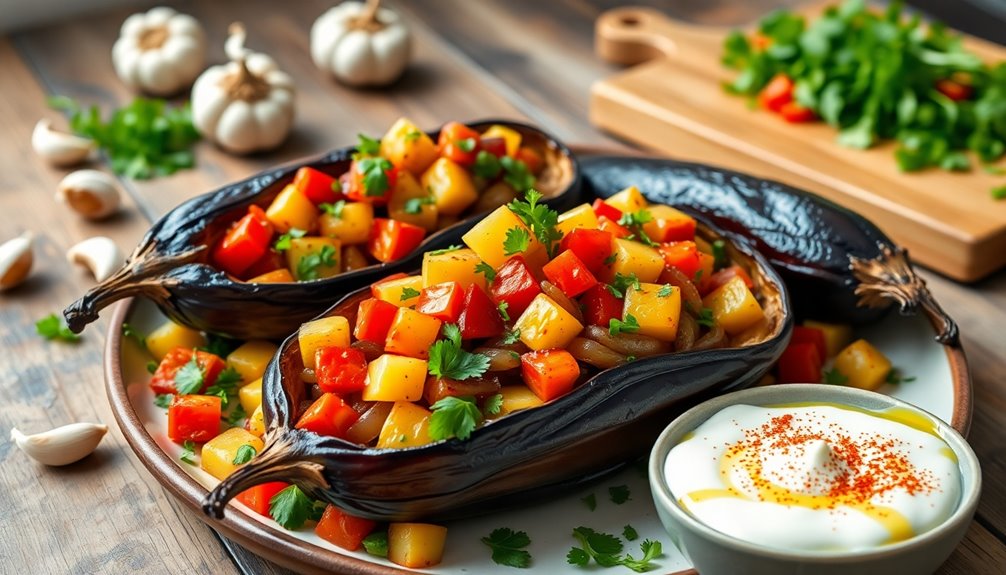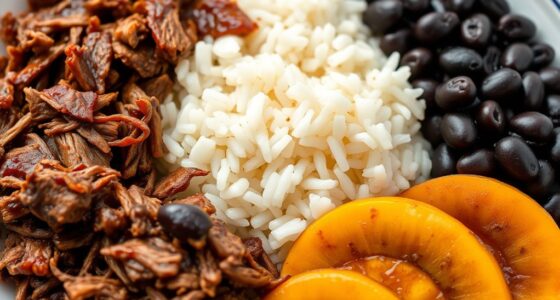Baked vegetables in Georgian style are a delicious way to celebrate seasonal produce. You'll typically use eggplants, potatoes, bell peppers, and onions, sautéed and combined with tomatoes and spices for rich flavors. Olive oil, fresh herbs, and a tangy yogurt sauce elevate the dish even further. Not only are these baked vegetables nutritious and versatile, but they also reflect Georgia's culinary traditions. Stick around to discover more about their history and preparation techniques!
History
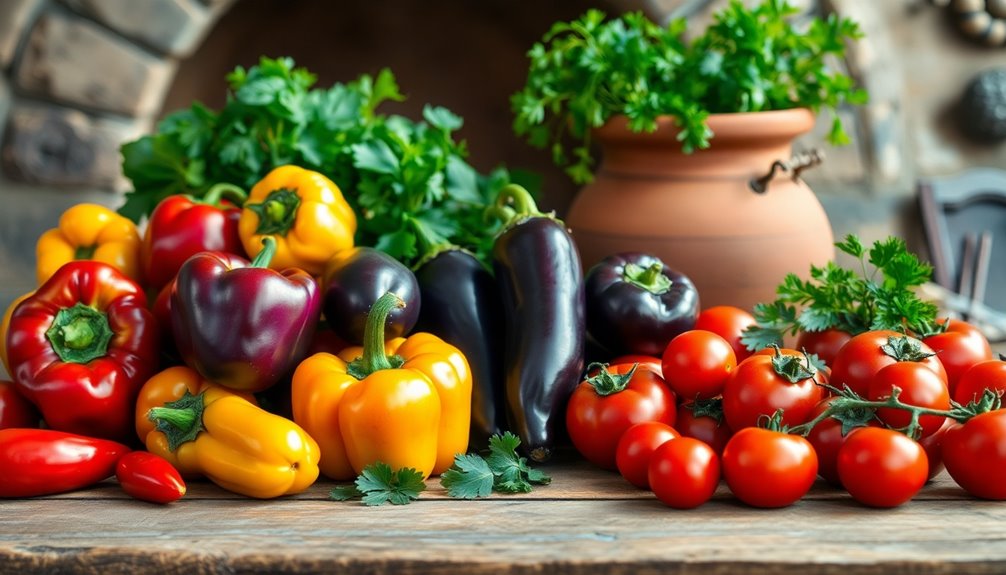
The history of baked vegetable dishes in Georgian cuisine reveals a rich tapestry of resourcefulness and tradition.
These dishes, like Ajapsandali, showcase how home cooks creatively used seasonal produce, especially during difficult times. Historically, baked vegetable dishes were staples for the working class, reflecting a culture that embraced affordability and availability.
The prominence of baking vegetables grew during the Soviet era, when diverse crops flourished across the land. Families passed down recipes, preserving their culinary heritage and regional variations.
During the Soviet era, the art of baking vegetables blossomed, enriching Georgian culinary traditions and honoring regional diversity.
At Georgian supras, baked vegetables symbolize hospitality, celebrating fresh, local ingredients. By enjoying these dishes, you connect with the spirit of Georgia's past and the enduring importance of sharing food with loved ones.
Recipe
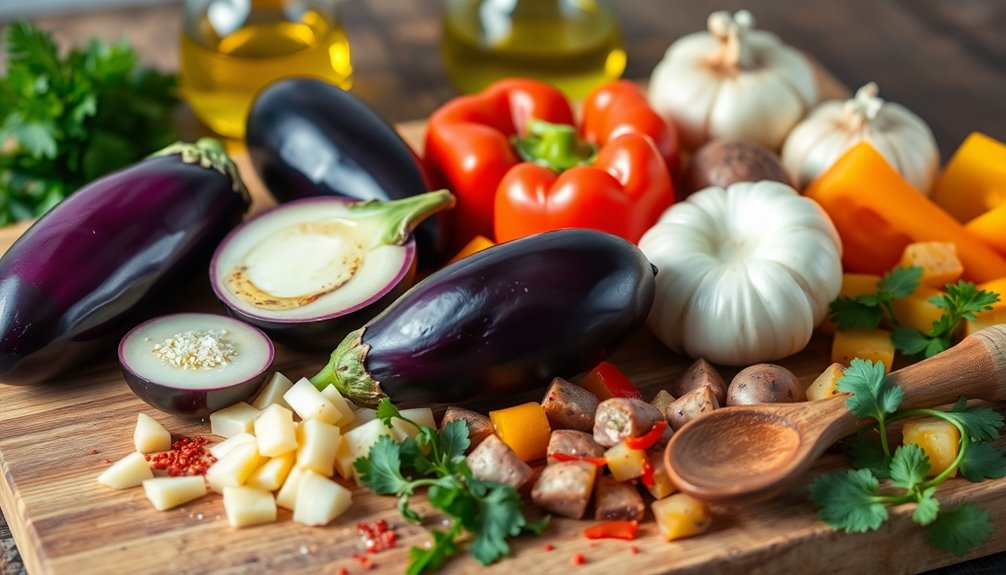
To begin, select a variety of seasonal vegetables that are fresh and ripe. The key to achieving a truly authentic Georgian flavor lies in the quality of ingredients and the use of fresh herbs.
This dish isn't only visually appealing with its colorful medley of ingredients but also packed with nutrients, making it a perfect addition to any meal. Pair the baked vegetables with a cool, tangy yogurt sauce to elevate the dish and create a refreshing contrast.
Ingredients
- 2 medium eggplants
- 2 large potatoes
- 2 bell peppers (any color)
- 1 onion
- 4 cloves of garlic
- 4 tablespoons of olive oil
- 1 teaspoon of paprika
- 1 teaspoon of salt
- 1/2 teaspoon of black pepper
- Fresh cilantro (for garnish)
- Fresh parsley (for garnish)
- Fresh basil (for garnish)
- Yogurt (for serving)
In a preheated oven at 400°F (200°C), start by preparing the vegetables. Slice the eggplants in half lengthwise and scoop out some of the flesh to create a hollow base.
Dice the removed eggplant flesh, potatoes, bell peppers, and onion. In a skillet, heat olive oil over medium heat, add the diced vegetables and minced garlic, and sauté until softened.
Season with paprika, salt, and black pepper. Fill the hollowed eggplants with the sautéed vegetable mixture, place them on a baking sheet, and drizzle with additional olive oil.
Bake for about 30-35 minutes, or until the eggplants are tender and golden brown. Garnish with fresh herbs and serve with yogurt on the side.
When cooking baked vegetables in Georgian style, feel free to experiment with your choice of vegetables based on the season or your personal preferences.
You can also add cheese, such as feta or sulguni, for a creamy touch. Additionally, allowing the vegetables to marinate in the olive oil and spices for about 30 minutes before baking can enhance their flavor even further.
Enjoy this dish warm or at room temperature, making it a versatile option for any occasion!
Cooking Steps
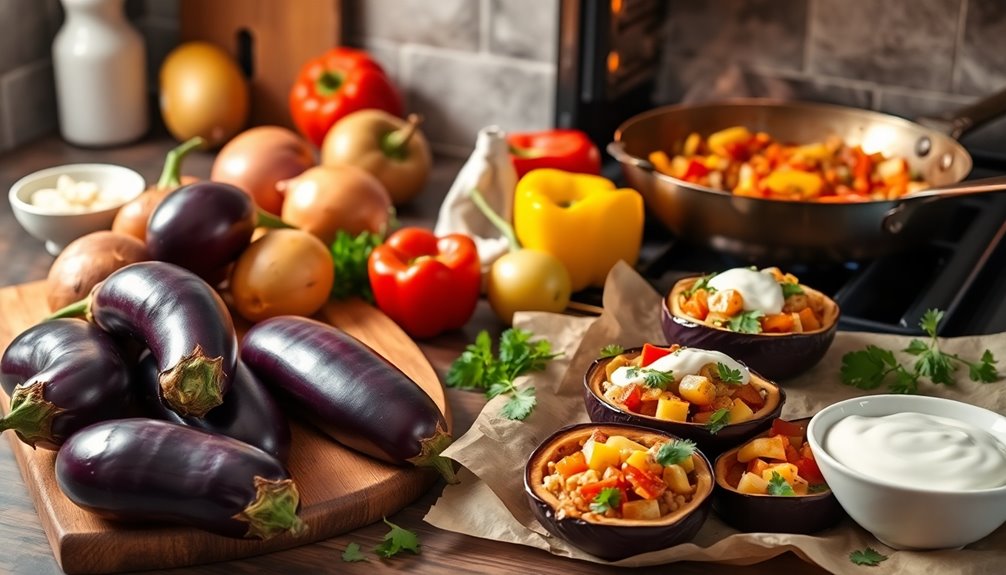
To kick off the cooking process, you'll want to prepare and chop your eggplants, ensuring they're ready for the next steps.
Start sautéing onions until they turn translucent, then add diced tomatoes and your choice of spices.
Let everything simmer until the flavors meld beautifully before garnishing with fresh herbs for that perfect finishing touch.
Step 1. Prepare and Chop Eggplants
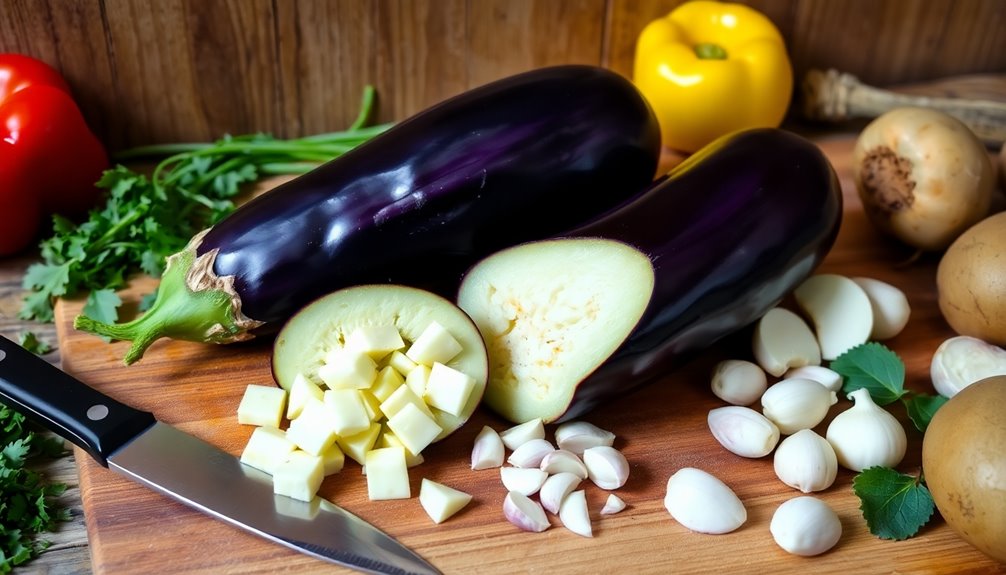
Start by cutting the eggplants in half lengthwise and carefully hollowing out the flesh, leaving about 1/4-inch of skin to maintain their structure.
Next, sprinkle the cut sides with salt and let them sit for 30 minutes to draw out excess moisture and bitterness.
After that, rinse the salted eggplants under cold water and pat them dry with a paper towel to remove any remaining moisture.
Drizzle the eggplant halves with olive oil, enhancing their flavor and preventing them from drying out during baking.
Finally, chop the hollowed-out eggplant flesh into small pieces. You'll mix these with other sautéed vegetables before stuffing them back into the eggplant shells, creating a delicious filling.
Step 2. Sauté Onions Until Translucent
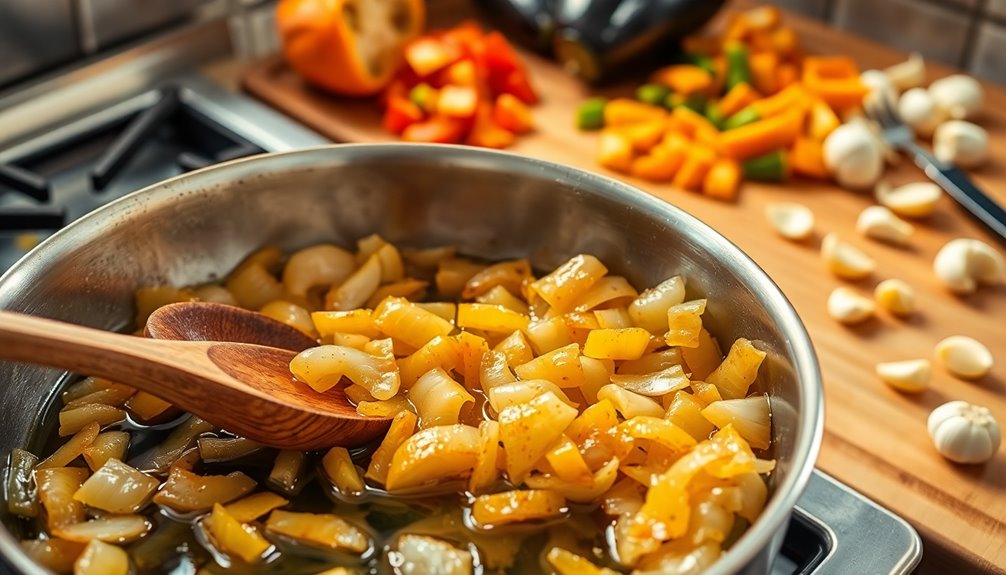
Heating a tablespoon of vegetable oil in a large saucepan over medium heat sets the stage for perfect sautéed onions.
Once the oil's shimmering, add diced onions to the pan. Sauté the onions for about 5 minutes, stirring occasionally, until they turn translucent and aromatic.
This translucent state means they're soft and have released their natural sweetness, which enhances the overall flavor of your vegetable stew. Be careful not to let them brown too quickly; you want that delicate texture.
Incorporating these sautéed onions into your baked vegetable dishes adds depth and richness, elevating the flavors to new heights.
Enjoy the delightful aroma filling your kitchen as you prepare this essential step for a truly delicious meal.
Step 3. Add Diced Tomatoes and Spices
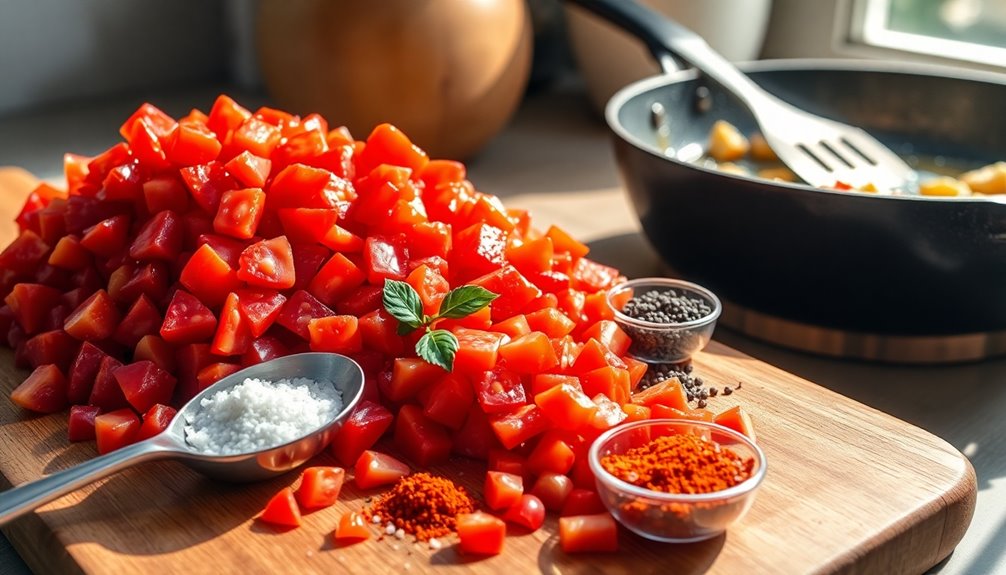
With the onions now translucent and fragrant, it's the perfect moment to introduce diced tomatoes and spices into the mix.
Add the diced tomatoes, which will enhance moisture and create a rich base for your dish. Next, sprinkle in ground coriander, cayenne pepper, and salt to season the vegetables, ensuring a well-rounded flavor profile.
Stir everything together to distribute the spices evenly. Once combined, add the eggplant and cover the pot initially; this will help steam the vegetables and soften them beautifully.
Remember to stir regularly, preventing sticking and promoting even cooking. This step sets the foundation for a delicious baked vegetable dish that captures the essence of Georgian flavors.
Step 4. Simmer Until Flavors Meld
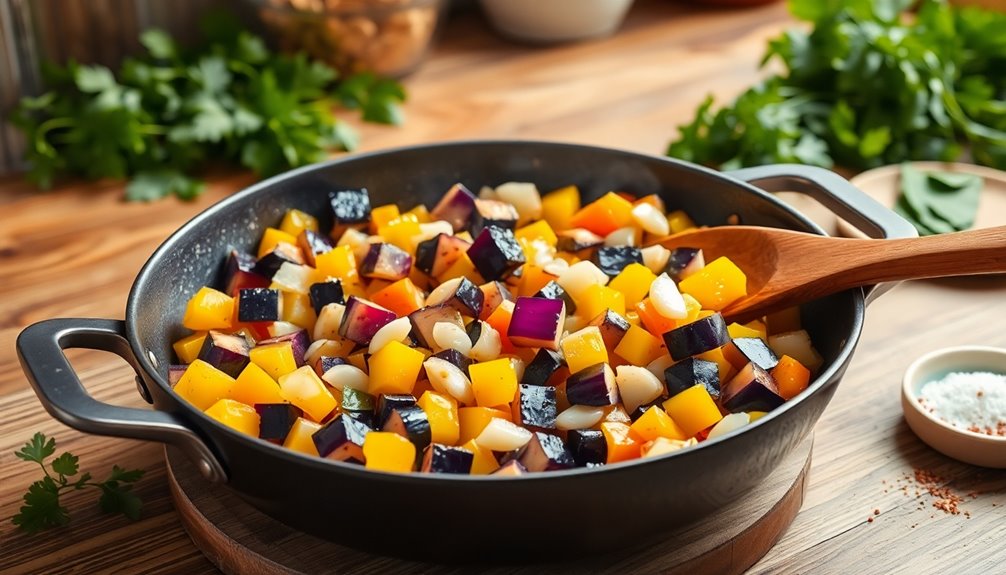
As you cover the pot, let the mixture simmer over low heat, allowing the flavors to meld beautifully. This step is crucial to achieving a harmonious blend of tastes.
Simmer until flavors meld for about 10-20 minutes, stirring occasionally to prevent sticking. If the stew seems too thick, add water to adjust the consistency, ensuring it remains cohesive.
When you see the vegetables becoming tender, it's time to add the tomato paste and the vibrant red pepper. Stir well to combine and let it cook a bit longer, allowing those flavors to deepen.
Step 5. Garnish With Fresh Herbs
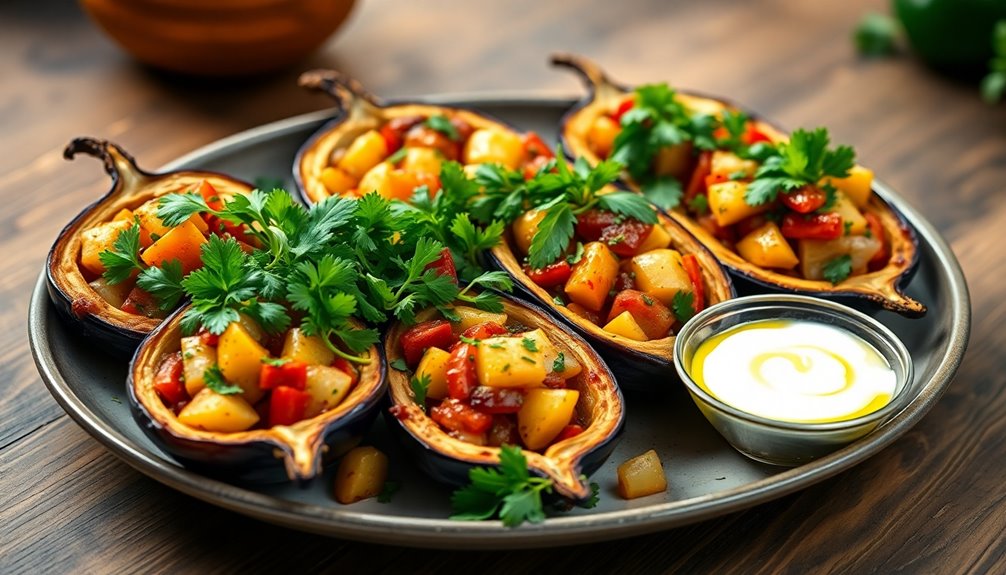
Once your baked vegetables are beautifully cooked, it's time to elevate the dish with fresh herbs.
Start by chopping fresh cilantro, parsley, or basil to enhance the flavor and presentation. Add these chopped herbs just before serving to keep their vibrant color and fresh taste. Additionally, fresh herbs are packed with antioxidants that combat oxidative stress, boosting the dish's health benefits. Incorporating these herbs can also help address potential nutrient deficiencies common in vegan diets.
For an aromatic touch, consider including dill or tarragon, which pair wonderfully with the earthy flavors of your vegetables.
Don't forget to drizzle high-quality olive oil or walnut oil over the dish; it adds richness and complements the herbs perfectly.
For an extra visual appeal, you can also garnish with pomegranate seeds. This will create a striking contrast and offer a delightful burst of sweetness, making your dish truly irresistible. Additionally, the inclusion of fresh herbs can provide antioxidants present that may help reduce inflammation.
Final Thoughts
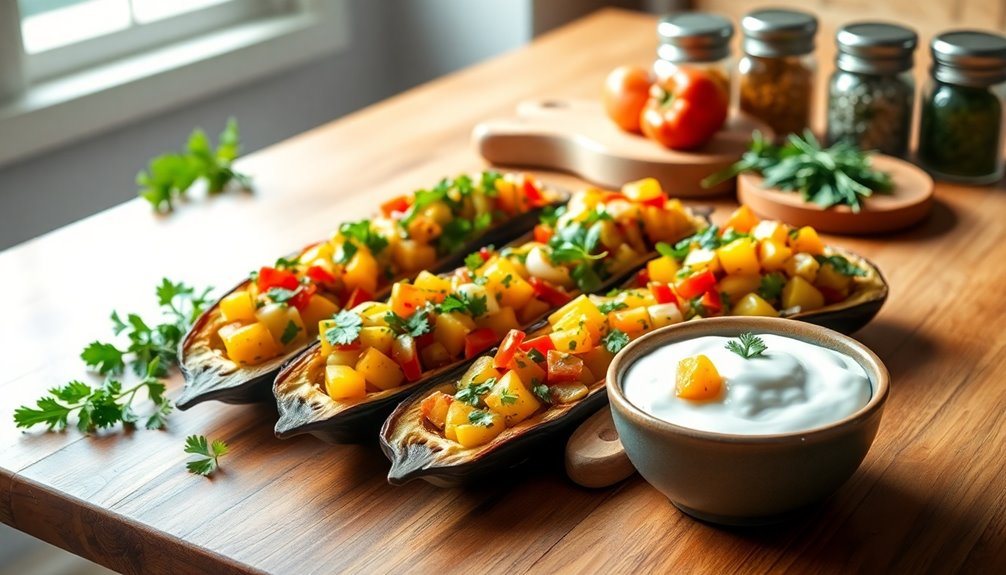
Baked vegetables in Georgian style offer a delightful way to enjoy seasonal produce while embracing the region's rich culinary heritage.
This eggplant dish, filled with sautéed vegetables and drizzled with olive oil, showcases the vibrant flavors and colors of the ingredients. The traditional baking process enhances the natural sweetness, making each bite memorable.
This vibrant eggplant dish, brimming with sautéed vegetables and olive oil, transforms natural sweetness into a memorable culinary experience.
You can elevate your meal with thoughtful food styling, presenting these baked vegetables alongside tangy yogurt or fresh herbs for a refreshing contrast. Additionally, incorporating a low-carb meal option can further enhance the health benefits of your dish.
Plus, if you have leftovers, you'll find that they taste even better the next day, thanks to the flavors melding together.
Enjoy this versatile dish as part of your meal prep, enjoying the health benefits and deliciousness it brings to your table.
Frequently Asked Questions
What Is a Key Ingredient in Georgian Cuisine?
A key ingredient in Georgian cuisine is eggplant. You'll find it in various dishes, where its rich texture and ability to absorb flavors shine through.
Another essential is walnuts, especially in dishes like pkhali, where they create a creamy paste.
Fresh herbs, like cilantro and parsley, add brightness, while garlic enhances the overall flavor.
Spices such as coriander and ground pepper give Georgian dishes their distinctive taste and aroma, making them truly unique.
What Are the Different Types of Pkhali?
Did you know there are over 200 types of pkhali in Georgian cuisine? Each version showcases different vegetables like beets, spinach, or eggplant.
The vibrant fuchsia beet pkhali stands out, while the green spinach variant offers a fresh taste. You can personalize your pkhali with various herbs and spices, such as coriander or red pepper flakes.
It's typically served at a supra, often garnished with pomegranate seeds for an extra pop of flavor and color.
Is Pkhali Healthy?
Yes, pkhali is healthy! It's packed with nutrients from vegetables like spinach and beets, which boost your fiber intake and aid digestion.
The walnuts provide heart-healthy omega-3 fatty acids, while garlic adds flavor and potential immune benefits.
Since pkhali is low in calories, it fits well into a balanced diet.
You'll enjoy its rich taste and vibrant colors while reaping the benefits of its wholesome ingredients.
